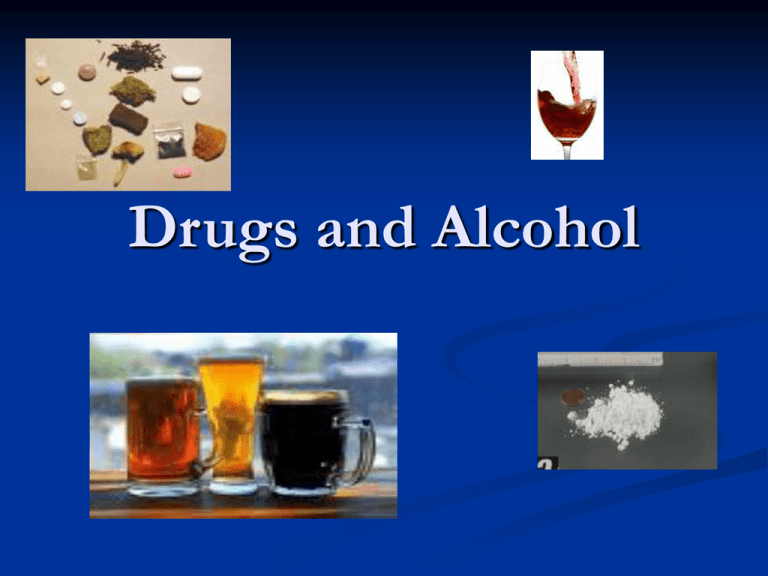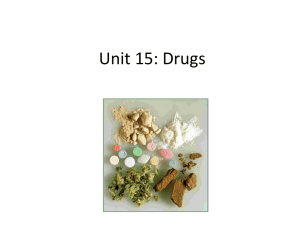Drugs and Alcohol
advertisement

Drugs and Alcohol Cocaine Obtained from the leaves of the coca plant Ancient use in S. America Religious, Social, Euphoriant, and Medicinal Active alkaloid 1st purified from the leaves in 1860 – What we commonly know as Cocaine. Cocaine extracted in the form of coca paste Paste approx 50-60% purity Stimulant of the Central Nervous System Early Years Proven to be one of the 1st local anesthetics for surgery Incorporated into numerous medicines and beverages including Coca-Cola Harrison Narcotic Act banned its use in 1914 Recreational use increased dramatically in the late 1960’s Inexpensive “crack” cocaine use spread in the late 1970’s Cocaine Hydrochloride Paste is treated with numerous chemicals to oxidize and purify the paste to form the water soluble cocaine hydrochloride powder Can be close to 100% pure Can be injected, inhaled as powder, or ingested orally Cannot be smoked Freebase Cocaine A.k.a. Crack Cocaine Similar to the unpurified insoluble coca paste Cannot be inhaled (as powder) or injected because it is not water soluble Cocaine is absorbed immediately into blood via the lungs, reaching the brain in about 5 seconds High typically lasts 5-10 minutes Effects of Short Term Use Moderate euphoria lasts for 60-90 min State of anxiety lasts for hours Thoughts race, rapid speech Sleep delayed Appetite suppressed Depressive state follows Serious negative effects on the CNS Long-Term Use Anxiety and sleep deprivation increase Suspiciousness, paranoia, and persecutory fears Heart Attack Irregular heart rhythm Seizures Alcohol/Cocaine is the largest two drug combination resulting in death Amphetamines Used for over 60 years therapeutically for numerous disorders Used in WW II to fight fatigue and enhance performance Widespread abuse began in 1940’s with students and truck drivers to stay awake and increase alertness Were used as appetite suppressants Also a stimulant Physiological Effects Increased BP Decreased HR Increased alertness Psychomotor stimulant Loss of appetite Feeling of power Euphoria Excitement Mood elevation Increased motor/speech activity Effects Moderate Use Respiratory stimulation Slight tremors Restlessness Greater increase in motor activity Insomnia Agitation High Dose Repetitive purposeless acts Sudden outbursts of aggression/violence Paranoid delusions Severe anorexia Amphetamine Psychosis: paranoid ideation Dependence and Tolerance Use becomes compulsive Tolerance develops rapidly Necessitates the need for markedly higher doses Tolerance to the euphoriant effects develops which causes prolonged binging ICE Freebase form of methamphetamine Effects similar to those of cocaine Extremely potent High is intense and long lasting Chronic use can result in serious psychiatric, cardiovascular, metabolic and neuromuscular changes Other behavioral stimulants include ephedrine and methylphenidate (Ritalin) Caffeine Most commonly consumed psychoactive drug in the world Average intake per person per day is between 80 to 400 milligrams Consumption of caffeine is not considered drug abuse Effects Increased energy A sense of well-being Faster and clearer flow of thought Reduced fatigue Need for sleep is delayed Caffeine causes a slight stimulant action on the heart Increases the workload cardiac contractility Dilates coronary arteries More oxygen to the heart Effects Chronic use associated with habituation and tolerance Quitting may cause withdrawal: Headaches Drowsiness Fatigue Negative mood Nicotine Primary active ingredient in tobacco One of the three most widely used psychoactive drugs Caffeine Alcohol Few or no therapeutic applications Important because of widespread use and toxicity Statistics Responsible for the deaths of 1100 Americans every day Each day 6000 American teenagers try their first cigarette 3000 children become regular smokers 1000 of these will die from smoking related disease 9 in 10 smokers become addicted before age 21 Smoking identified as the major preventable cause death and disability Smoking Diseases Lung Cancer Cancer of the mouth and throat Chewing tobacco Cardiovascular Disease Carbon monoxide decreases amount of oxygen delivered to the heart while nicotine increases the workload Carbon monoxide and nicotine increase narrowing (atherosclerosis) and clotting (thrombosis) in the coronary arteries Increased risk of coronary heart disease Smoking Diseases About 4,000 Americans per year die from lung cancer caused by second-hand smoke 37,000 deaths per year from heart disease caused by second hand smoke Marijuana Marijuana is the dried mix of flowers and leaves form the female Cannabis Sativa plant The major biologically active chemical compound in cannabis is tetrahydrocannabinol (THC) Has psychoactive and physiological effects The most common method of absorption is smoking Either in a loosely rolled cigarette or through a pipe or water pipe Effects Effects on the respiratory system are the same as smoking cigarettes. Chronic use of marijuana can reduce testosterone levels in men as well as reducing the production of sperm. Smoking Marijuana during pregnancy has many of the same effect as smoking cigarettes, mild fetal growth retardation. There have been cases of infants born with THC dependence and withdrawal. Physical Effects Senses may be enhanced Perception of time is usually altered Mild euphoria, relaxation, and relief from anxiety Contrary to popular belief, illusions and hallucinations occur infrequently Medicinal Marijuana The use of marijuana for medicinal proposes dates back more then 5ooo years. However, the debate over medicinal marijuana rages today in the United States. Therapeutic Benefits of Marijuana Reduction of intraocular pressure associated with glaucoma. Use as a bronchodilator in asthmatics. Relief of muscle spasms in such disorders as multiple sclerosis. Preventing seizures associated with epilepsy. Treatment of depression. Treatment of chronic pain, and migraines. Alcohol Alcohol is a depressant, which means it slows the function of the central nervous system. Alcohol actually blocks some of the messages trying to get to the brain. This alters a person's perceptions, emotions, movement, vision, and hearing. Binge drinking- For a man, 5 or more drinks in one evening, for a woman, 4 drinks. Blood Alcohol Content Dependent on: Presence of food Rate of consumption Concentration of alcohol Drinkers body composition Effects of Alcohol Affected judgment Muscle coordination is depressed Staggered walk and slurred speech Emotions erratic Memory impaired Vomiting Confusion Coma Death Chronic Effects of Alcohol Irritation, Bleeding, and Malabsorption Alcohol irritates stomach lining Irritates esophagus resulting in mild chest pain Causes ulcers and stomach bleeding Liver Disease Fatty liver Alcoholic hepatitis (jaundice) Cirrhosis of the liver (non reversible) Chronic Effects of Alcohol Hematological System Anemia Effects white blood cells (increases susceptibility to infection) Bruising easily & clotting problems Cardiovascular System AHMD (alcoholic heart muscle disease) Shortness of breath & dramatic enlargement of heart Arrhythmias Increase risk of stroke Why Do Teens Drink??? Curiosity To feel good, reduce stress, and relax To fit in To feel older Why you shouldn’t drink Puts your HEALTH at RISK Punishment is severe Bad decisions Review?? Name two drugs that are considered stimulants. What is the primary ingredient in tobacco? What are some long term effects of using tobacco? What is considered binge drinking? How will you avoid being pressured into using drugs or alcohol?




